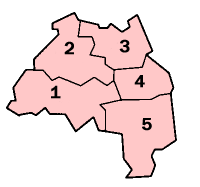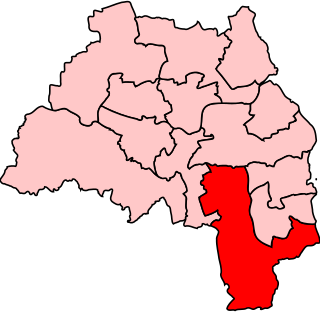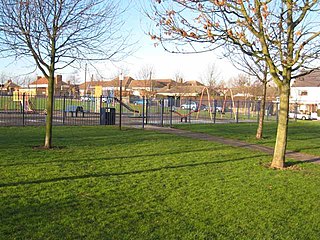
Sunderland, also known as the City of Sunderland, is a metropolitan borough with city status in the metropolitan county of Tyne and Wear, England. It is named after its largest settlement, Sunderland, spanning a far larger area, including nearby towns including Washington, Hetton-le-Hole and Houghton-le-Spring, as well as the surrounding villages and hamlets. The district also forms a large majority of Wearside which includes Chester-le-Street in County Durham.

Hetton-le-Hole is a town and civil parish in the City of Sunderland, Tyne and Wear, England. It is in the historic county of Durham. A182 runs through the town, between Houghton-le-Spring and Easington Lane, off the A690 and close to the A1(M).

Wearside is a built-up area in County Durham and Tyne and Wear, England. It is named after the River Wear which flows through it and traditionally all in the County of Durham.

Easington Lane is a village in the City of Sunderland metropolitan borough in the county of Tyne and Wear, North East England. Historically part of County Durham and located between Hetton-le-Hole, Seaham, Peterlee and Durham. It had a population of 4,044 at the 2001 Census, increasing to 7,193 at the 2011 Census.

There are 10 civil parishes in the ceremonial county of Tyne and Wear, most of the county being unparished; North Tyneside and South Tyneside are completely unparished. It is the county of England with the lowest number of civil parishes. At the 2001 census, there were 41,044 people living in the 10 parishes, accounting for 3.8 per cent of the county's population. A civil parish is the lowest unit of local government in England.

Houghton and Washington East was, from 1997 until 2010, a constituency represented in the House of Commons of the Parliament of the United Kingdom. It elected one Member of Parliament (MP) by the first past the post system of election. A seat with similar boundaries, Houghton and Washington, existed from 1983 until 1997.

City of Durham is a constituency represented in the House of Commons of the UK Parliament since 2019 by Mary Foy of the Labour Party.

Fulwell is an affluent area and former civil parish in the Sunderland district, in the county of Tyne and Wear, England. The parish was abolished in 1928 as a result of the Sunderland Corporation Act 1927, and the area incorporated into the former County Borough of Sunderland. It borders Seaburn, Southwick, Monkwearmouth, and Roker, and the district border between Sunderland and South Tyneside. Fulwell ward, including South Bents and Seaburn, is the least socially deprived of the city's 25 wards. Until 1974 it was in County Durham.

Birtley is a town in the Metropolitan Borough of Gateshead, in Tyne and Wear, England. It is situated to the south of Gateshead and is conjoined to Chester-le-Street across the county boundary in County Durham.

Sunderland City Council is the local authority of Sunderland, a metropolitan borough with city status in the ceremonial county of Tyne and Wear in North East England. It is one of five such councils in Tyne and Wear and one of 36 in England. It provides the majority of local government services in Sunderland.

Houghton-le-Spring was a county constituency of the House of Commons of the Parliament of the United Kingdom from 1885 to 1983. Centred on the town of Houghton-le-Spring, now part of the City of Sunderland, it elected one Member of Parliament (MP) by the first-past-the-post system of election.

Chopwell is a village in the Gateshead district, in the county of Tyne and Wear, England, 3 miles (4.8 km) west of Rowlands Gill and 1 mile (1.6 km) north of Hamsterley. At the 2011 Census, it had a population of 9,395.

East Rainton is a village and former civil parish, now in the parish of Hetton, in the Sunderland district, in the county of Tyne and Wear, England. It is situated alongside the A690 road between Sunderland and Durham, near Houghton-le-Spring. In 1931 the parish had a population of 1711. East Rainton was formerly a township and chapelry in the parish of Houghton-le-Spring, from 1866 East Rainton was a civil parish in its own right, on 1 April 1937 the parish was abolished to form Hetton, part also went to Houghton le Spring.

Offerton is a hamlet in the Sunderland district, of Tyne and Wear, England. It is situated about 4 miles (6.4 km) west of Sunderland city centre.

Coxlodge is an area situated between Fawdon, Gosforth and Kenton in Newcastle upon Tyne, in the county of Tyne and Wear, England. Until 1974 it was in Northumberland.

Harraton is a suburb of Washington, in the Sunderland metropolitan borough, in Tyne and Wear, England. Harraton is near the River Wear and is 3 miles north-east of Chester-le-Street, 2 miles south-west of Washington town centre and 9 miles south-southwest of Sunderland.

The Tyneside Passenger Transport Executive was the operations arm of the Tyneside Passenger Transport Authority, created by the Transport Act 1968. and came into operation on 1 January 1970.

Harton is a suburban area of South Shields, South Tyneside, Tyne and Wear, England. It was historically a village, however as the urban area grew it merged with its adjacent villages to become part of the town. Some of the original village buildings are still intact today, such as St Peter's Church. Until 1974 it was in County Durham.
Eppleton Colliery Welfare Ground is a football ground located in Hetton-le-Hole in the City of Sunderland, Tyne and Wear. It was created as part of the miners' welfare in order to provide recreational facilities to the coal miners at the Eppleton Colliery. It featured facilities for both cricket and Association football. It became the home ground of Eppleton CWFC in 1929. The team folded in 2005.
The county of Durham has returned 7 MPs to the UK Parliament since 1983. Under the Local Government Act 1972, which came into effect on 1 April 1974, the boundaries of the historic/administrative county were significantly altered with the north-east of the county, comprising more than half the electorate, being transferred to the new metropolitan county of Tyne and Wear. In addition, the borough of Hartlepool was included in the new county of Cleveland. These changes were reflected in the following redistribution of parliamentary seats which did not come into effect until the 1983 general election, resulting in a reduction in the county's representation from 16 to 7 MPs.



















